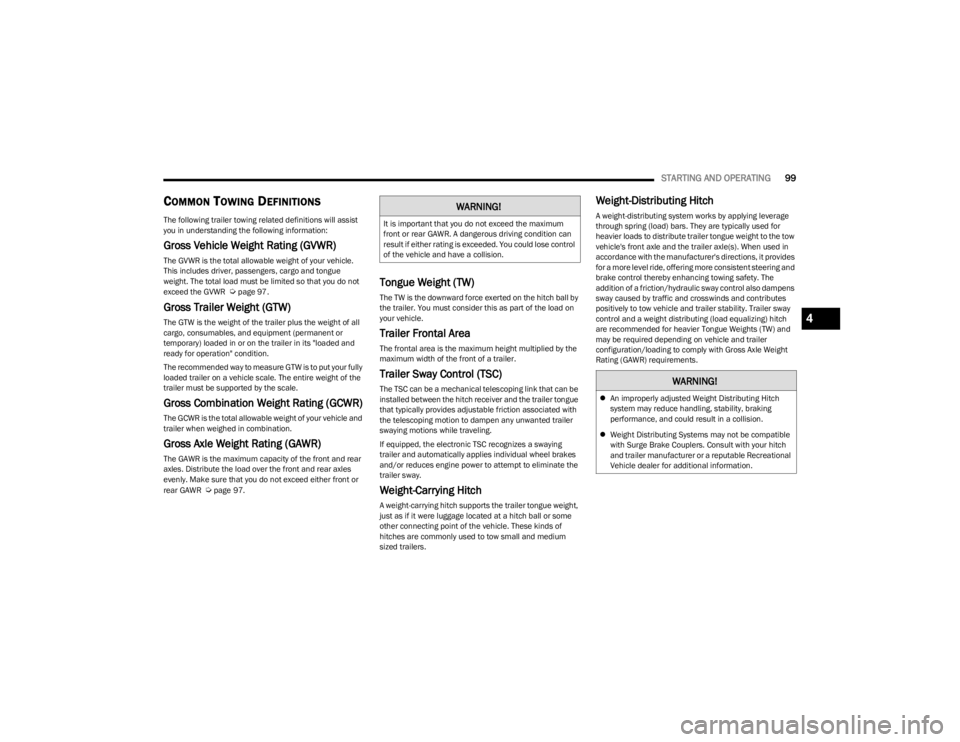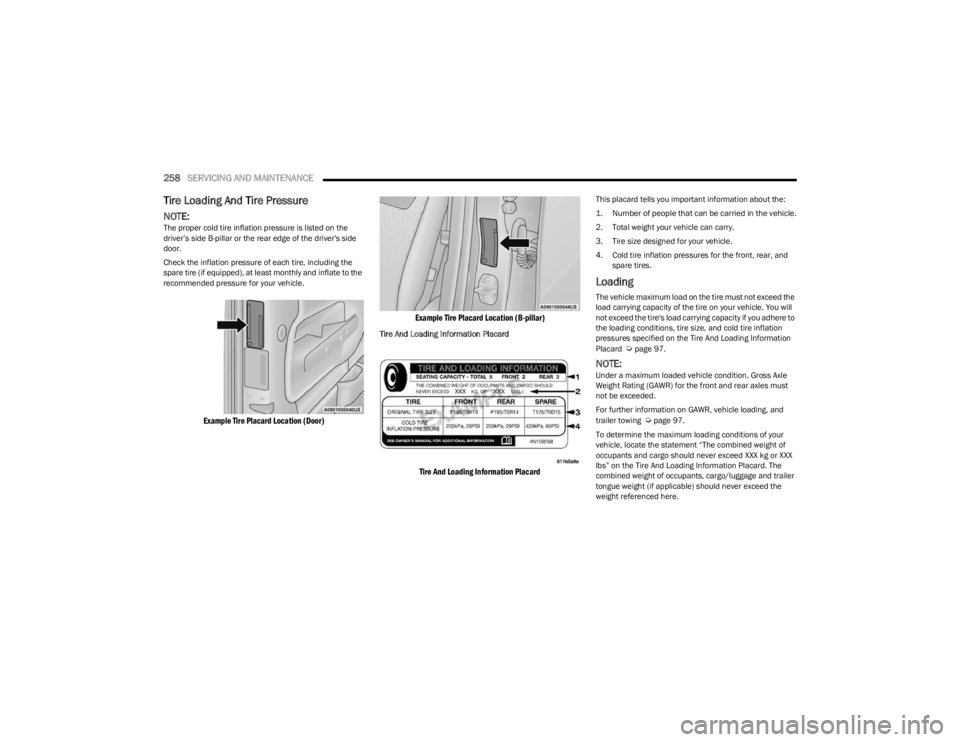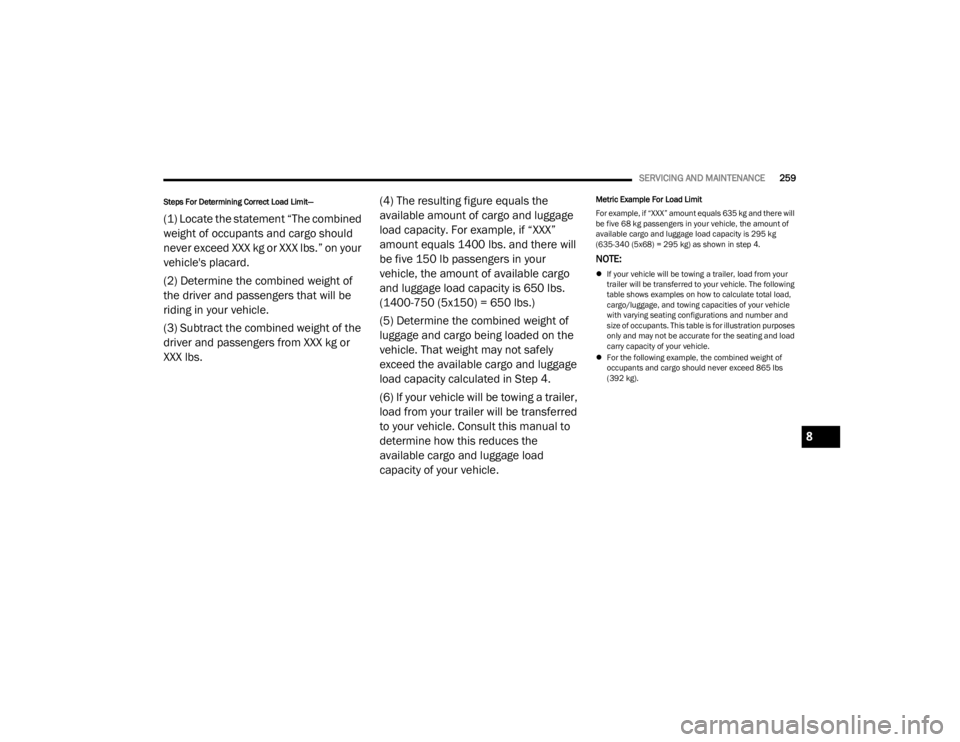towing capacity DODGE CHALLENGER 2023 Owners Manual
[x] Cancel search | Manufacturer: DODGE, Model Year: 2023, Model line: CHALLENGER, Model: DODGE CHALLENGER 2023Pages: 300, PDF Size: 12.82 MB
Page 100 of 300

98STARTING AND OPERATING
VEHICLE CERTIFICATION LABEL
Your vehicle has a Vehicle Certification Label affixed to the
drivers side B-pillar or the rear of the driver’s door.
The label contains the following information:
Name of manufacturer
Month and year of manufacture
Gross Vehicle Weight Rating (GVWR)
Gross Axle Weight Rating (GAWR) front
Gross Axle Weight Rating (GAWR) rear
Vehicle Identification Number (VIN)
Type of vehicle
Month, Day, and Hour of manufacture (MDH)
The bar code allows a computer scanner to read the VIN.
GROSS VEHICLE WEIGHT RATING
(GVWR)
The GVWR is the total allowable weight of your vehicle.
This includes driver, passengers, and cargo. The total load
must be limited so that you do not exceed the GVWR.
GROSS AXLE WEIGHT RATING (GAWR)
The GAWR is the maximum capacity of the front and rear
axles. Distribute the load over the front and rear axles
evenly. Make sure that you do not exceed either front or
rear GAWR.
OVERLOADING
The load carrying components (axle, springs, tires, wheels,
etc.) of your vehicle will provide satisfactory service as
long as you do not exceed the GVWR and the front and
rear GAWR.
The best way to figure out the total weight of your vehicle
is to weigh it when it is fully loaded and ready for
operation. Weigh it on a commercial scale to ensure that
it is not over the GVWR.
Figure out the weight on the front and rear of the vehicle
separately. It is important that you distribute the load
evenly over the front and rear axles.
Overloading can cause potential safety hazards and
shorten useful service life. Heavier axles or suspension
components do not necessarily increase the vehicle's
GVWR.
LOADING
To load your vehicle properly, first figure out its empty
weight, axle-by-axle and side-by-side. Store heavier items
down low and be sure you distribute their weight as evenly
as possible. Stow all loose items securely before driving. If
weighing the loaded vehicle shows that you have
exceeded either GAWR, but the total load is within the
specified GVWR, you must redistribute the weight.
Improper weight distribution can have an adverse effect
on the way your vehicle steers and handles and the way
the brakes operate.
NOTE:Refer to the “Vehicle Certification Label” affixed to the rear
of the driver's door for your vehicle's GVWR and GAWRs
Úpage 98.
TRAILER TOWING
In this section, you will find safety tips and information on
limits to the type of towing you can reasonably do with your
vehicle. Before towing a trailer, carefully review this
information to tow your load as efficiently and safely as
possible.
To maintain warranty coverage, follow the requirements
and recommendations in this manual concerning vehicles
used for trailer towing.
Manual Transmission — If Equipped
Trailer towing with this vehicle is not recommended.
WARNING!
Because the front wheels steer the vehicle, it is
important that you do not exceed the maximum front or
rear GAWR. A dangerous driving condition can result if
either rating is exceeded. You could lose control of the
vehicle and have a collision.
23_LA_OM_EN_USC_t.book Page 98
Page 101 of 300

STARTING AND OPERATING99
COMMON TOWING DEFINITIONS
The following trailer towing related definitions will assist
you in understanding the following information:
Gross Vehicle Weight Rating (GVWR)
The GVWR is the total allowable weight of your vehicle.
This includes driver, passengers, cargo and tongue
weight. The total load must be limited so that you do not
exceed the GVWR
Úpage 97.
Gross Trailer Weight (GTW)
The GTW is the weight of the trailer plus the weight of all
cargo, consumables, and equipment (permanent or
temporary) loaded in or on the trailer in its "loaded and
ready for operation" condition.
The recommended way to measure GTW is to put your fully
loaded trailer on a vehicle scale. The entire weight of the
trailer must be supported by the scale.
Gross Combination Weight Rating (GCWR)
The GCWR is the total allowable weight of your vehicle and
trailer when weighed in combination.
Gross Axle Weight Rating (GAWR)
The GAWR is the maximum capacity of the front and rear
axles. Distribute the load over the front and rear axles
evenly. Make sure that you do not exceed either front or
rear GAWR
Úpage 97.
Tongue Weight (TW)
The TW is the downward force exerted on the hitch ball by
the trailer. You must consider this as part of the load on
your vehicle.
Trailer Frontal Area
The frontal area is the maximum height multiplied by the
maximum width of the front of a trailer.
Trailer Sway Control (TSC)
The TSC can be a mechanical telescoping link that can be
installed between the hitch receiver and the trailer tongue
that typically provides adjustable friction associated with
the telescoping motion to dampen any unwanted trailer
swaying motions while traveling.
If equipped, the electronic TSC recognizes a swaying
trailer and automatically applies individual wheel brakes
and/or reduces engine power to attempt to eliminate the
trailer sway.
Weight-Carrying Hitch
A weight-carrying hitch supports the trailer tongue weight,
just as if it were luggage located at a hitch ball or some
other connecting point of the vehicle. These kinds of
hitches are commonly used to tow small and medium
sized trailers.
Weight-Distributing Hitch
A weight-distributing system works by applying leverage
through spring (load) bars. They are typically used for
heavier loads to distribute trailer tongue weight to the tow
vehicle's front axle and the trailer axle(s). When used in
accordance with the manufacturer's directions, it provides
for a more level ride, offering more consistent steering and
brake control thereby enhancing towing safety. The
addition of a friction/hydraulic sway control also dampens
sway caused by traffic and crosswinds and contributes
positively to tow vehicle and trailer stability. Trailer sway
control and a weight distributing (load equalizing) hitch
are recommended for heavier Tongue Weights (TW) and
may be required depending on vehicle and trailer
configuration/loading to comply with Gross Axle Weight
Rating (GAWR) requirements.WARNING!
It is important that you do not exceed the maximum
front or rear GAWR. A dangerous driving condition can
result if either rating is exceeded. You could lose control
of the vehicle and have a collision.
WARNING!
An improperly adjusted Weight Distributing Hitch
system may reduce handling, stability, braking
performance, and could result in a collision.
Weight Distributing Systems may not be compatible
with Surge Brake Couplers. Consult with your hitch
and trailer manufacturer or a reputable Recreational
Vehicle dealer for additional information.
4
23_LA_OM_EN_USC_t.book Page 99
Page 104 of 300

102STARTING AND OPERATING
Perform the maintenance listed in the “Scheduled
Servicing” Úpage 223. When towing a trailer, never
exceed the GAWR or GCWR ratings.
Towing Requirements — Tires
Do not attempt to tow a trailer while using a compact
spare tire.
Do not drive more than 50 mph (80 km/h) when towing
while using a full size spare tire.
Proper tire inflation pressures are essential to the safe
and satisfactory operation of your vehicle. For proper
tire inflation procedures.
Check the trailer tires for proper tire inflation pressures
before trailer usage.
Check for signs of tire wear or visible tire damage
before towing a trailer.
Replacing tires with a higher load carrying capacity will
not increase the vehicle's GVWR and GAWR limits.
For further information
Úpage 253.
Towing Requirements — Trailer Brakes
Do not interconnect the hydraulic brake system or
vacuum system of your vehicle with that of the trailer.
This could cause inadequate braking and possible
personal injury.
An electronically actuated trailer brake controller is
required when towing a trailer with electronically actu -
ated brakes. When towing a trailer equipped with a
hydraulic surge actuated brake system, an electronic
brake controller is not required.
Trailer brakes are recommended for trailers over
1,000 lb (453 kg) and required for trailers in excess of
2,000 lb (907 kg).
Towing Requirements — Trailer Lights And
Wiring
Whenever you pull a trailer, regardless of the trailer size,
stoplights and turn signals on the trailer are required for
motoring safety.
The Trailer Tow Package may include a four- and seven-pin
wiring harness. Use a factory approved trailer harness and
connector.
NOTE:Do not cut or splice wiring into the vehicle’s wiring
harness.
CAUTION!
Do not tow a trailer at all during the first 500 miles
(805 km) the new vehicle is driven. The engine, axle
or other parts could be damaged.
Then, during the first 500 miles (805 km) that a
trailer is towed, do not drive over 50 mph (80 km/h)
and do not make starts at full throttle. This helps the
engine and other parts of the vehicle wear in at the
heavier loads.
WARNING!
Do not connect trailer brakes to your vehicle's
hydraulic brake lines. It can overload your brake
system and cause it to fail. You might not have
brakes when you need them and could have an acci -
dent.
Towing any trailer will increase your stopping
distance. When towing, you should allow for addi -
tional space between your vehicle and the vehicle in
front of you. Failure to do so could result in an
accident.
CAUTION!
If the trailer weighs more than 1,000 lb (453 kg)
loaded, it should have its own brakes and they should
be of adequate capacity. Failure to do this could lead to
accelerated brake lining wear, higher brake pedal
effort, and longer stopping distances.
23_LA_OM_EN_USC_t.book Page 102
Page 260 of 300

258SERVICING AND MAINTENANCE
Tire Loading And Tire Pressure
NOTE:The proper cold tire inflation pressure is listed on the
driver’s side B-pillar or the rear edge of the driver's side
door.
Check the inflation pressure of each tire, including the
spare tire (if equipped), at least monthly and inflate to the
recommended pressure for your vehicle.
Example Tire Placard Location (Door) Example Tire Placard Location (B-pillar)
Tire And Loading Information Placard
Tire And Loading Information Placard
This placard tells you important information about the:
1. Number of people that can be carried in the vehicle.
2. Total weight your vehicle can carry.
3. Tire size designed for your vehicle.
4. Cold tire inflation pressures for the front, rear, and
spare tires.
Loading
The vehicle maximum load on the tire must not exceed the
load carrying capacity of the tire on your vehicle. You will
not exceed the tire's load carrying capacity if you adhere to
the loading conditions, tire size, and cold tire inflation
pressures specified on the Tire And Loading Information
Placard
Úpage 97.
NOTE:Under a maximum loaded vehicle condition, Gross Axle
Weight Rating (GAWR) for the front and rear axles must
not be exceeded.
For further information on GAWR, vehicle loading, and
trailer towing
Úpage 97.
To determine the maximum loading conditions of your
vehicle, locate the statement “The combined weight of
occupants and cargo should never exceed XXX kg or XXX
lbs” on the Tire And Loading Information Placard. The
combined weight of occupants, cargo/luggage and trailer
tongue weight (if applicable) should never exceed the
weight referenced here.
23_LA_OM_EN_USC_t.book Page 258
Page 261 of 300

SERVICING AND MAINTENANCE259
Steps For Determining Correct Load Limit—
(1) Locate the statement “The combined
weight of occupants and cargo should
never exceed XXX kg or XXX lbs.” on your
vehicle's placard.
(2) Determine the combined weight of
the driver and passengers that will be
riding in your vehicle.
(3) Subtract the combined weight of the
driver and passengers from XXX kg or
XXX lbs. (4) The resulting figure equals the
available amount of cargo and luggage
load capacity. For example, if “XXX”
amount equals 1400 lbs. and there will
be five 150 lb passengers in your
vehicle, the amount of available cargo
and luggage load capacity is 650 lbs.
(1400-750 (5x150) = 650 lbs.)
(5) Determine the combined weight of
luggage and cargo being loaded on the
vehicle. That weight may not safely
exceed the available cargo and luggage
load capacity calculated in Step 4.
(6) If your vehicle will be towing a trailer,
load from your trailer will be transferred
to your vehicle. Consult this manual to
determine how this reduces the
available cargo and luggage load
capacity of your vehicle.
Metric Example For Load Limit
For example, if “XXX” amount equals 635 kg and there will
be five 68 kg passengers in your vehicle, the amount of
available cargo and luggage load capacity is 295 kg
(635-340 (5x68) = 295 kg) as shown in step 4.
NOTE:
If your vehicle will be towing a trailer, load from your
trailer will be transferred to your vehicle. The following
table shows examples on how to calculate total load,
cargo/luggage, and towing capacities of your vehicle
with varying seating configurations and number and
size of occupants. This table is for illustration purposes
only and may not be accurate for the seating and load
carry capacity of your vehicle.
For the following example, the combined weight of
occupants and cargo should never exceed 865 lbs
(392 kg).
8
23_LA_OM_EN_USC_t.book Page 259
Page 288 of 300

286
Brake Assist System .................................................... 160
Brake Control System .................................................. 160
Brake Fluid .......................................................... 240
, 279
Brake System ...................................................... 240, 273
Fluid Check..................................................... 240, 279
Master Cylinder ....................................................... 240
Parking ....................................................................... 74
Warning Light ................................................... 64
, 273
Brake/Transmission Interlock........................................79
Break-In Recommendations, New Vehicle .................... 74
Brightness, Interior Lights .............................................. 43
Bulb Replacement ....................................................... 250
Bulbs, Light.......................................................... 198
, 250
CCamera, Rear ..................................................................96
Capacities, Fluid ........................................................... 277
Caps, Filler Fuel .............................................................................96
Oil (Engine) .............................................................. 228
Radiator (Coolant Pressure)................................... 239
Car Washes .................................................................. 270
Carbon Monoxide Warning .......................................... 198
Cargo Vehicle Loading..........................................................97
Cargo Net .........................................................................55
CD.................................................................................. 133
Cellular Phone .............................................................. 158
Certification Label ...........................................................98
Chains, Tire................................................................... 267
Chart, Tire Sizing .......................................................... 255
Check Engine Light (Malfunction Indicator Light) .........70
Checking Your Vehicle For Safety ............................... 196
Checks, Safety.............................................................. 196 Child Restraint .............................................................. 185
Child Restraints
Booster Seats .......................................................... 187
Child Seat Installation ............................................. 194How To Stow An unused ALR Seat Belt .................192Infant And Child Restraints ..................................... 186
Lower Anchors And Tethers For Children............... 188
Older Children And Child Restraints....................... 187
Seating Positions ..................................................... 188
Clean Air Gasoline ........................................................ 275
Cleaning Wheels .....................................................................266
Climate Control ............................................................... 45
Cold Weather Operation ................................................. 74
Compact Spare Tire ...................................................... 265
Contract, Service .......................................................... 282
Controls ......................................................................... 125
Cooling Pressure Cap (Radiator Cap) ..........................239
Cooling System ............................................................. 237 Adding Coolant (Antifreeze) ....................................238
Coolant Level ................................................. 238
, 239
Cooling Capacity ...................................................... 277
Disposal Of Used Coolant ....................................... 239 Drain, Flush, And Refill............................................238
Inspection ................................................................ 239
Points To Remember............................................... 239
Pressure Cap ...........................................................239
Radiator Cap ............................................................239Selection Of Coolant (Antifreeze) ........ 238
, 277, 278
Corrosion Protection ..................................................... 270
Cruise Control ................................................................. 84
Cruise Control (Speed Control) ...................................... 84 Cruise Light ..................................................................... 69 Cupholders
Illuminated................................................................. 50
Customer Assistance ................................................... 280
Customer Programmable Features ............................. 107
Cybersecurity ................................................................ 106
DDaytime Running Lights ................................................. 40 Dealer Service .............................................................. 231
Defroster, Windshield .................................................. 197
De-Icer, Remote Start .................................................... 19
Delay (Intermittent) Wipers............................................ 44
Deleting A Phone .......................................................... 139
Deluxe Vehicle Security System .................................... 20
Diagnostic System, Onboard ......................................... 69Dimmer Control .............................................................. 43Dipsticks Oil (Engine) .............................................................. 230
Disabled Vehicle Towing .............................................. 221
Disc Drive ...................................................................... 133
Disconnecting ............................................................... 139
Disposal Antifreeze (Engine Coolant) .................................... 239
Disturb........................................................................... 141
Door Ajar ......................................................................... 64
Door Ajar Light ................................................................ 64
Door Locks Automatic .................................................................. 24
Remote Keyless Entry ............................................... 12
Doors ............................................................................... 21
Drag & Drop .................................................................. 123
Drive Modes.................................................................. 154
Driver Memory Presets ................................................ 131
Driver Memory Settings ................................................. 27
23_LA_OM_EN_USC_t.book Page 286
Page 289 of 300

287
Driver’s Seat Back Tilt ....................................................28
DrivingThrough Flowing, Rising, Or Shallow Standing Water .................................................. 105
EElectric Brake Control System..................................... 160Anti-Lock Brake System ......................................... 159
Electronic Roll Mitigation .............................. 160
, 163
Electrical Power Outlets..................................................50 Electronic Power Distribution Center (Fuses) ............ 242
Electronic Stability Control (ESC) ................................ 161
Electronic Throttle Control Warning Light...................... 65Emergency Trunk Release.............................................. 55
Emergency, In Case Of Freeing Vehicle When Stuck .................................. 220
Jacking..................................................................... 202
Jump Starting ................................................. 216
, 217
Towing ..................................................................... 221
Emission Control System Maintenance.........................70
Engine .................................................................. 228
, 229
Air Cleaner ............................................................... 233 Break-In Recommendations ..................................... 74
Checking Oil Level .................................................. 230Compartment ................................................. 228
, 229
Compartment Identification ................................... 228 Coolant (Antifreeze) ................................................ 238
Cooling..................................................................... 237
Exhaust Gas Caution .............................................. 198
Fails To Start .............................................................. 74
Flooded, Starting ....................................................... 74
Fuel Requirements ................................................. 274 Jump Starting ................................................. 216
, 217
Oil ...........................................................231, 277, 278 Oil Filler Cap ............................................................. 228
Oil Filter ....................................................................233Oil Selection ................................................... 231
, 277
Oil Synthetic ............................................................. 232
Starting....................................................................... 71
Engine Oil Life Reset
b
............................................... 59
Enhanced Accident Response Feature ............. 184, 222
Ethanol .......................................................................... 275
Exhaust Gas Cautions ..................................................198
Exhaust System .................................................. 198
, 237
Exterior Lighting .............................................................. 39
Exterior Lights ........................................................39
, 198
FFiller Location Fuel ......................................................... 96
Filters Air Cleaner ............................................................... 233
Air Conditioning ................................................49
, 234
Engine Oil ................................................................. 233
Engine Oil Disposal..................................................233
Flashers ......................................................................... 199 Hazard Warning ....................................................... 199
Turn Signals ...............................................42
, 69, 198
Flash-To-Pass .................................................................. 41
Flooded Engine Starting ................................................. 74
Fluid Capacities ............................................................277
Fluid Leaks ....................................................................198
Fluid Level Checks Brake ........................................................................ 240
Cooling System ........................................................ 238
Engine Oil ................................................................. 230
Transfer Case .......................................................... 241 Fluid, Brake................................................................... 279
Fog Lights........................................................................ 42
Fold-Flat Seats ......................................................... 28
, 30
Forward Collision Warning ........................................... 167
Freeing A Stuck Vehicle ............................................... 220
Fuel................................................................................ 274 Additives .................................................................. 275
Clean Air .................................................................. 275
Ethanol..................................................................... 275Filler Cap (Gas Cap) .................................................. 96
Gasoline ................................................................... 274
Materials Added ...................................................... 275
Methanol ................................................................. 275
Octane Rating.................................................274
, 278
Requirements .......................................................... 274
Specifications .......................................................... 278
Tank Capacity .......................................................... 277
Fueling ............................................................................ 96 Fuses ............................................................................. 242
GGarage Door Opener (HomeLink) .................................. 36Gas Cap (Fuel Filler Cap) ............................................... 96
Gasoline, Clean Air ....................................................... 275
Gasoline, Reformulated ............................................... 275
Gear Ranges ................................................................... 79
Glass Cleaning .............................................................. 272
Gross Axle Weight Rating ........................................ 98
, 99
Gross Vehicle Weight Rating .................................. 98, 99
GVWR .............................................................................. 98
11
23_LA_OM_EN_USC_t.book Page 287